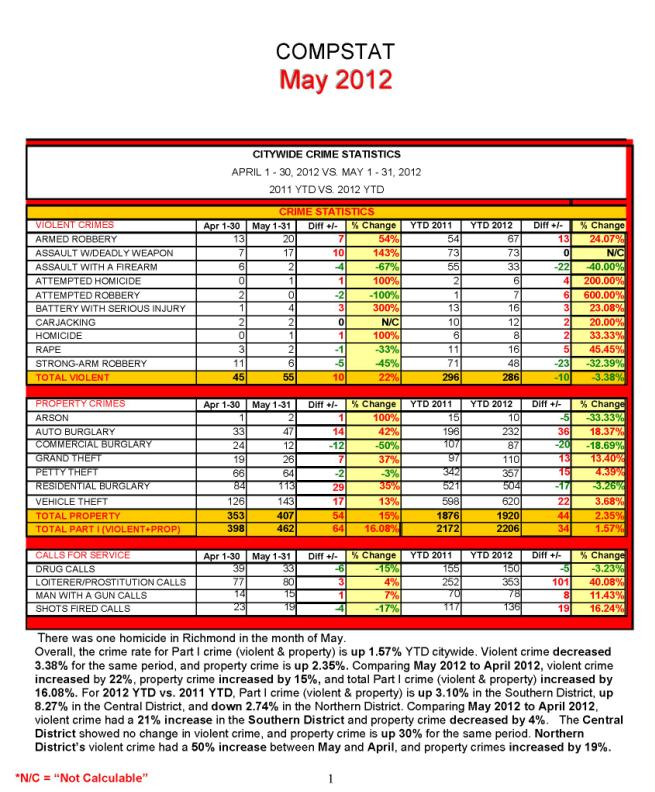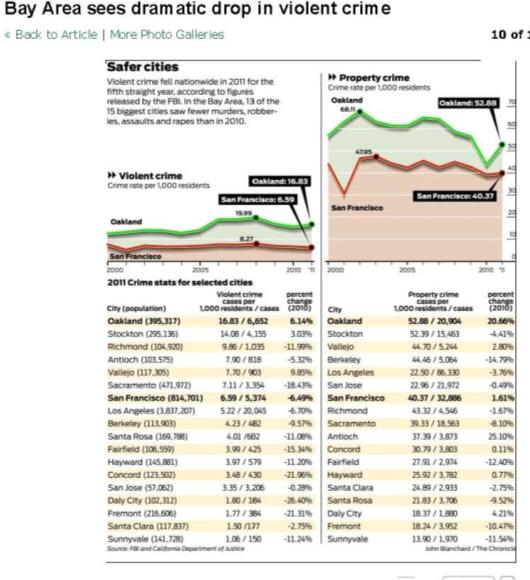A story in today’s San Francisco Chronicle described dramatic drops in violent crime in most Bay Area Cities. Richmond showed an 11.99% drop and a rate that is still too high but lower than both Stockton and Oakland.
Richmond’s crime stats are published monthly on the City’s website at http://www.ci.richmond.ca.us/Archive.aspx?AMID=72. Year to date, Richmond remains slightly below last year at this time, continuing a downward trend that has continued for several years.

Bay Area sees dramatic drop in violent crime
Demian Bulwa
Sunday, June 17, 2012
The Bay Area extended a run of historic drops in violent crime last year, defying fears that with a poor economy stripping away jobs, social programs and police resources, thugs would rule the streets.
Thirteen of the region's 15 biggest cities recorded fewer murders, robberies, assaults and rapes last year than in 2010, according to new numbers released by the FBI and analyzed by The Chronicle. Three cities - Fremont, Concord and Daly City - enjoyed declines of better than 20 percent.
Although conventional wisdom links hard times to high crime, the factors behind the rise and fall of mayhem and theft have never been well understood. If the recession fed desperation, said Robert Weisberg, a criminal justice expert at the Stanford Law School, it may also have created a sense of "communal solidarity."
Crime went down, he noted, in some of the worst years of the Great Depression.

Focusing resources
San Francisco Public Defender Jeff Adachi said the economy has "forced the law enforcement community and the criminal justice system to use its resources more effectively. We're putting more resources into prosecuting - and defending - the more serious crimes."
In growing safer, the Bay Area's big cities are in lockstep with a national trend that has seen violence drop for five consecutive years, following a period of rising crime that stirred alarm. Violent crime fell 4 percent nationally from 2010 to 2011, while property theft crimes fell 0.8 percent - the ninth straight decline.
In the Bay Area, the gains are perhaps clearest in San Francisco, which averaged 94 homicides a year from 2004 to 2008. In the past three years, the totals were 45, 48 and 50.
Long-term drop
The news looks even better over the longer term, with many big California cities cutting violent crime nearly in half since a peak in the late 1980s - a time associated with the crack cocaine epidemic. Unprecedented decreases followed in the 1990s, and some experts now see a sustained leveling.
The statistics, though, reveal difficulties in some places. Violent crime went up 6 percent in 2011 in Oakland, which had the fourth-highest rate among U.S. cities with more than 100,000 people. Oakland was safer than only Flint, Mich., Detroit and St. Louis.
Still, Oakland's violent crime rate is down 19 percent from its recent high point in 2008.
"The city is still struggling to devise a response to the crime problem that the city can unite around," said David Sklansky, a law professor at UC Berkeley who has written extensively about policing.
Fewer cops
Vallejo, which like Oakland has slashed its police force in recent years, saw a 10 percent jump in violent crime. But that's still down 25 percent from its recent high in 2006.
Homicides in San Jose nearly doubled from 2010, to 39. However, overall violent crime dropped slightly year-to-year in that city, and is down 42 percent over the past decade.
Police officials in the Bay Area said they could only speculate on why crime is falling. But many said they had gotten smarter - strengthening relationships with residents and community aid groups, using technology like crime mapping to add officers to troubled neighborhoods, and cracking down on the small number of hard-core offenders who drive violent crime.
"Community partnerships have been huge here," said Fairfield police Capt. Darrin Moody. "For years we tried to do it ourselves, and we should have realized a long time ago that we couldn't."
Moody pointed to the Leaven, a Fairfield nonprofit that since 2005 has gone into low-income apartment complexes to tutor children after school. Crime dropped at each site, Moody said.
Enlisting the feds
Gregg Ogelsby, a police detective in Daly City, singled out the effort in recent years to bring federal racketeering cases against gang members, which can put them in prison for years even if they don't personally take part in a killing or assault. The cases have weakened MS-13, a gang that plagues San Francisco's Mission District.
The federal prosecutions "can wipe out entire groups of violent offenders," Oglesby said.
Crime statistics tend to fluctuate, and the numbers have ticked up in some cities this year. Violent crime is up 19 percent in Oakland, 10 percent in Fremont and 6 percent in Fairfield, which has recorded seven homicides - two more than in all of 2011.
Moody said Fairfield was seeing early fallout from the state's effort to cut overcrowding in its prisons, known as realignment, which began in October. "We anticipated an increase in crime, and we're taking strides to deal with it," he said.
But in an example of the disagreements that often arise among those analyzing crime statistics, others said reforms to the corrections system were making cities safer.
"The fact that we're seeing violent crimes reduced when a record number of people are being released from state prison is significant," Adachi said. "We have to make sure we continue to reform our system in the right direction."
Demian Bulwa is a San Francisco Chronicle staff writer. E-mail: dbulwa@sfchronicle.com Twitter: @demianbulwa
http://sfgate.com/cgi-bin/article.cgi?f=/c/a/2012/06/17/MNQB1P0SBQ.DTL

